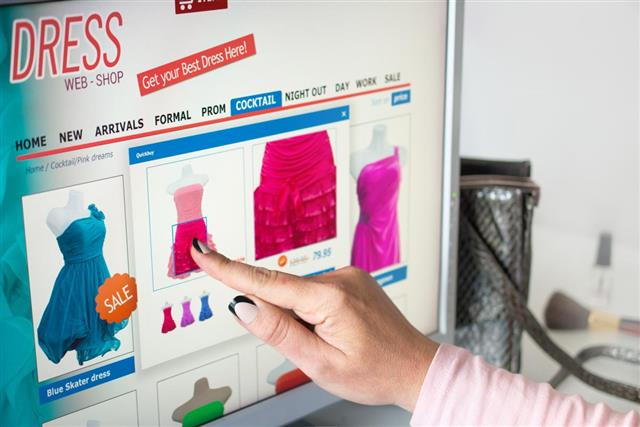
Nowadays you can buy anything online, often at a better deal and in a wider selection of features than in a retail store. But is shopping online as risky as some people think it is? Here are a few tips to ensure that your online shopping trip is a safe one.
Linda Orlando
With just a click of your mouse, you can buy virtually any product online―from electronics to gifts, clothing, food, and even cars and homes. The Internet has made it possible for consumers to shop at literally thousands of online stores, browse through dozens of products to find just what they’re looking for, and pay for their purchases without ever leaving home. For many people, e-commerce has completely replaced a Saturday afternoon trip to the mall.
There used to be many inherent flaws and risks associated with online shopping. Computer glitches caused orders to get lost, and poor customer service made it impossible to get problems resolved. Shoppers would often be at the mercy of cybercrooks always on the prowl to take advantage of their naivety and cheat them. But in recent years, e-commerce has become much more safe and secure, thanks to the growing competition of online shops, the security services that rate e-commerce sites, more advanced encryption technology, and shoppers increased Internet savvy. Things can still go wrong, but there are several things you can control that will make your online shopping experience a good one.
Shop at only secure websites.
Secure e-commerce sites use encryption technology to transfer information from your computer to the merchant’s computer. Encryption scrambles the information you send, such as address, phone number, and credit card numbers, to prevent hackers from obtaining the information as it travels from your computer to the store’s computer. The only people who can unscramble the encryption are those who have legitimate access privileges. Usually you can tell if a website is secure if the URL of the site begins with https://. The ‘s’ at the end indicates that the website is secure. You may not actually see the ‘s’ until you proceed to the actual order page of the website.
Research the website before you place an order.
Online stores that also have an established brick-and-mortar presence, such as Target, Walmart, Barnes & Noble, and others, have websites that are very safe and secure. If the company is unfamiliar to you, do your homework before you trust them with your personal information. Reliable companies should display a physical business address and at least one telephone number. Call the phone number and ask questions to determine whether the business is legitimate. Ask any questions you may have, such as how they handle returns or complaints. You can also research a company by visiting ratings sites such as epinions.com, where other online shoppers write posts detailing their experiences with online shopping sites.
Read the website’s security policies and privacy statement.
Every reputable online shopping site provides information about how it processes your order, and what it does with the information it collects from you. The privacy policies should tell you what type of information they gather, what they do with it, and whether or not it will be shared with other companies. Often the merchant’s data security practices are also explained in the Privacy Policy.
Look for online merchants who are members of a program that gives a seal of approval to safe online shopping sites. TRUSTe, Verisign, and BBBonline are the most commonly seen programs. Be aware that a security policy and a seal of approval do not guarantee that a merchant will protect the privacy of your information indefinitely. You may have little control over your information if the company files for bankruptcy, sells its customer database, is purchased by another company, or has to give up its customer information for law enforcement investigations.
Use a credit card if at all possible.
The safest way to shop online is with a credit card, because if something goes wrong you are protected. The federal Fair Credit Billing Act gives you the right to dispute charges on your credit card, and you don’t have to pay anything on the balance while an investigation is being conducted. If it is determined that your card number was used without your authorization, you are responsible for only the first $50 in charges, but credit card companies rarely enforce this.
The best approach to online shopping is to use only one credit card for all online purchases, so it will be easier for you to detect incorrect charges. Make sure the card is a true credit card and not a debit card, check card, or ATM card. Shopping by check is never a good idea, since it leaves you vulnerable to bank fraud, and sending a money order doesn’t give you any protection if you have problems with the purchase. Debit and ATM cards are not protected by federal laws the way credit cards are.
Never, ever give out your Social Security number or information not related to your purchase.
There is never any reason for an online merchant to ask for your Social Security number, so if they do, this should be a huge red flag to you. Giving out your Social Security number could lead to having your identity stolen. Additionally, some online merchants try to get more information about you to target you for marketing purchases. You don’t need to provide information about your other interests, lifestyle, or annual income. Usually websites will mark with an asterisk the questions you are required to answer in order to make your purchase, but if a company requires information you aren’t comfortable in providing, then don’t order from them.
Always print out a copy of your order.
After you place an order online, you should receive a confirmation page that details your entire order, including charges, customer information you provided, product information, and a confirmation or order number. You should print out at least one copy of this page, as well as the page showing the company’s name, address, phone number, and return policy. You may also receive a confirmation message in your e-mail, and you should save and/or print this message as well.
Pay attention to the company’s shipping information and return policies.
A company must ship your order within the time stated in their ad. If no time frame is stated, the merchant must ship the product within 30 days, or give you the option of canceling the order and receiving a refund. Be sure to review the choices offered for shipping, and be sure you know the shipping and handling fees before you place the order. Find out how the merchant handles returns or complaints, and whether or not you will get a full refund if there is a problem with your order.
Last but not least―listen to your gut instinct.
If, while browsing through an online store’s information, you get a feeling that you shouldn’t shop there, don’t ignore those warning bells. There is much truth to the adage that if something doesn’t sound right, then it probably isn’t.
One of the best rules you can follow is to shop only with companies located in the United States, so you will have some legal recourse if your purchase results in a problem. When you shop within the U.S. you are protected by state and federal consumer laws. You might not get the same protection if you order something from a company located in another country.





